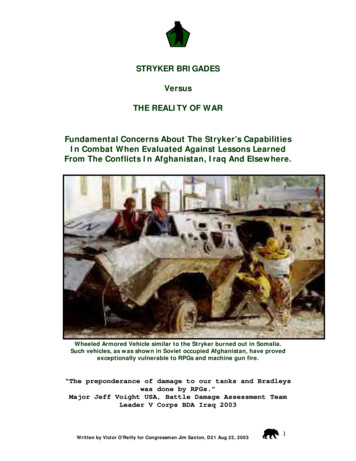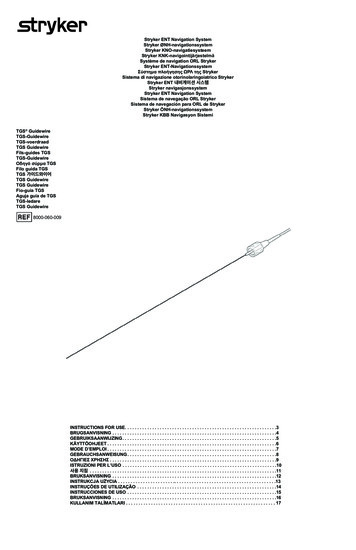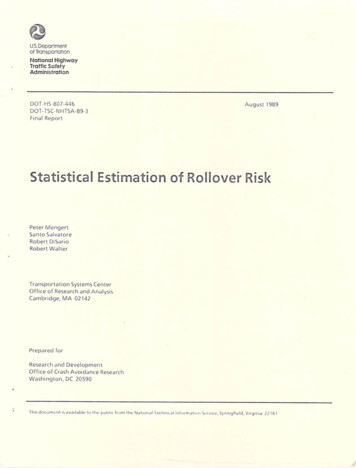
Transcription
STRYKER BRIGADESVersusTHE REALITY OF WARFundamental Concerns About The Stryker’s CapabilitiesIn Combat When Evaluated Against Lessons LearnedFrom The Conflicts In Afghanistan, Iraq And Elsewhere.Wheeled Armored Vehicle similar to the Stryker burned out in Somalia.Such vehicles, as was shown in Soviet occupied Afghanistan, have provedexceptionally vulnerable to RPGs and machine gun fire.“The preponderance of damage to our tanks and Bradleyswas done by RPGs.”Major Jeff Voight USA, Battle Damage Assessment TeamLeader V Corps BDA Iraq 2003Written by Victor O’Reilly for Congressman Jim Saxton, D21 Aug 22, 20031
A SIMPLE ISSUE:In a time of war, should the lives of American soldiersbe put at stake by – knowingly - fielding substandardvehicles procured to meet a symbolic peacetimeagenda?In peacetime, the procurement of military equipment resembles acommercial spectator sport where the rewards are profit and the penalty is loss.Of course, most thinking Americans know it should not be that way –because the lives of American soldiers, sailors, marines and airmen couldtheoretically be at stake - but their concerns are largely swept aside by theimperatives of a free market economy where the good, without question,outweighs the bad.Senators and Congressman, quite rightly, fight for their states, districts andparty interests. Defense contractors fight for their bottom line. The military fightfor their services.All of this is understandable, if less than ideal, in peacetime.But, we are at war, and, as this document is being written, Americansoldiers are being killed or injured virtually every day in Iraq – with equipmentlimitations making no small contribution.Apart from our tanks and Bradleys, virtually none of our vehicles haveany significant degree of RPG resistance, yet the RPG is the most predictableweapon, apart from the AK-47 that we are likely to encounter in any foreseeableconflict.The issue raised in this report is whether the US Army should be allowedto field the Stryker, a family of vehicles whose extensive deficiencies arecomprehensively laid out in the following pages, but which, for technical,bureaucratic and political reasons, has managed to elude the Department ofDefense’s Operational Test and Evaluation.In this document, we ask that this exercise in symbolism, instead ofsubstance, be stopped.There are far, far, better and more cost effective alternatives.More to the point, American lives, and the missions for which our soldiersfight, should not be put at risk unnecessarily.Victor O’Reilly cochraneinst@adelphia.netWritten by Victor O’Reilly for Congressman Jim Saxton, D21 Aug 22, 20032
CONTENTSSectionTitlePageExecutive Summary1.Introduction to the Stryker122.Lessons Learned from combat243.The Stryker Concept v Lessons Learned354.The Stryker: The Mobile Gun System465.The Stryker: Survivability examined556.The Stryker: Deployability examined607.The Stryker: Costs698.The Stryker: 3Author’s Note:This report contains serious criticisms of the Army’s decision to procureand field the Stryker. They are being advanced in the spirit of former Army Chiefof Staff General Sullivan’s comment that, “Disagreement is not disrespect.”The author has the greatest respect and affection for the Army but believesthat flawed decisions, particularly in a time of war, where lives are immediately atstake, must be opposed.Such is one’s right and duty in this great democracy. It was that samedemocracy that the US Army, to its enduring credit, originally fought for, andwon.This is a draft which will be refined and extended as additionalinformation becomes available. In that context, it is to be wished that soldiers ofcharacter will step up to disclose the truth. There are issues of principle at stakehere.Author: Victor O’Reilly cochraneinst@adelphia.netWritten by Victor O’Reilly for Congressman Jim Saxton, D21 Aug 22, 20033
EXECUTIVE SUMMARY:THE STRYKER ICV & SOME OF ITS PROBLEMSPoorly armoredand entirelyvulnerable toRPGs.Roughly the sizeof a school bus.A VERY largetarget.Lightly armoredand cannotshoot on themove.Cramped, withnumeroushuman factorproblems.Engine & othermechanicalproblems.Wheels & wellsextremelyvulnerable tosmall arms.The wheels givepoor off-roadperformance.Large turningcircle. Unsuitablefor urban combat.Expensive to buy.Over budget.Frighteninglyexpensive tooperate.Stabilityproblems. Proneto overturn.Bought to be C130 deployablebut too heavy.Written by Victor O’Reilly for Congressman Jim Saxton, D21 Aug 22, 20034
EXECUTIVE SUMMARY:STRYKER MOBILE GUN SYSTEM & ITS PROBLEMSAuto loader jamsand fails to selectcorrect ammunition.Muzzle blast friescrew and friendlytroops.Wheel design grosslyinadequate for such aheavy vehicle.Cannon toopowerful for StrykerChassis.Commander and Gunnerspositions so cramped theyfit less than 5 percent ofthe population.Only lightly armored:too heavy to up-armor.Written by Victor O’Reilly for Congressman Jim Saxton, D21 Aug 22, 2003Too heavy to be C130 deployable. Akey requirement.Poor off-roadperformance.Does not carryenough ready maingun Ammunition.5
EXECUTIVE SUMMARY:KEY FACTS ABOUT THE STRYKERThere are the strongest arguments for the Stryker program to becurtailed and the Stryker Mobile Gun System to be cancelled.The Stryker Concept reflected the vision of the previous Chief ofStaff of the Army, General Shinseki, who argued that the existing force was eithertoo heavy to be deployed quickly (tanks and infantry fighting vehicles) or toolight to be effective (airborne or light infantry). He attempted to solve adeployment problem by buying more hardware instead of restructuring the forceto make it more agile, and by talking to the Air Force and the Navy about lift.The 8 wheeled Stryker Light Armored Vehicle was selected(under debatable circumstances) to be the basis of a series of 6 Stryker Brigadestargeted at global deployability in 96 hours (an objective which was found to beinfeasible in a recent GAO report #03-81). They were to be transported by C-17sinto theater and C-130s intra theater. C-130 deployability was a key performanceparameter (KPP). Stryker Brigades were to be the US Army’s intervention forcepending the development of a new force, the Objective Force, which was to befielded in 2008 (an optimistic figure).General Shinseki’s vision came from a period during which thefuture of the Army seemed to lie, in the main, with peacekeeping – OperationsOther Than War. He did not change it after 911 although the requirementschanged dramatically because the United States was, is, and will continue, to be atwar.The Stryker program was supposed to be, in effect, ‘off theshelf.’ The Stryker, itself, was an evolution of the LAV III, a well proven lightlyarmored vehicle, albeit of limited operational capability (a very importantqualification). However, the Army system decided to modify it significantly andended up with a vehicle, or series of vehicles, which were vastly heavier than theLAV III and, indeed, too heavy to be C-130 deployable over tactically usefuldistances. Strykers were also marketed to Congress and elsewhere as beingcapable of ‘Full Spectrum Warfare’ which, palpably was not true. They could notstand up to heavy machine gun fire and were still entirely vulnerable to RocketPropelled Grenades – RPGs – and the weight of their increased armor impactednegatively on speed, reliability and off road performance.The basic Stryker family of vehicles, which were lightlyarmed, were supposed to be accompanied by a Mobile Armored Gun System.Although a type classified (fully Army tested and approved) tracked armored gun,the M8, already existed, the Army decided to try and put an M68A1 105mm gunon a Stryker chassis – and the results have been disastrous.Written by Victor O’Reilly for Congressman Jim Saxton, D21 Aug 22, 20036
Costs of 6 Brigades could reach 12-15 billion. The cost of theproposed 6 Stryker Brigades looks like it could reach 12-15 billion or more for aforce that brings little punch to the fight – at a time when we are at war.This 12 billion is made up of 6 brigades at 1.5 billion plus supportequipment and 3 billion in MILCON (Military Construction). The remaining 3billion relates to cost escalation and contingencies.The disturbingly high operational costs are not included.True cost of the Stryker. The true cost of the Stryker lies less in thefinancial outlay than in the waste of time and effort and in the distraction from thewarfighting and other capabilities the Army genuinely needs.Note. ‘The Stryker’ is actually a family of 8 wheeled lightlyarmored vehicles built on a common chassis. All suffer from the samefundamental deficiencies and vulnerabilities outlined in this report. However, theStryker Mobile Gun System, discussed in its own section, is particularlydysfunctional and is actually dangerous to its own crew.THE STRYKER VARIANTS ARE. Stryker ICV Infantry Carrier VehicleStryker MGS Mobile Gun SystemStryker ATGM Anti Tank Guided MissileStryker CV Commander’s VehicleStryker MC Mortar CarrierStryker RV Reconnaissance VehicleStryker ESV Engineer Squad VehicleStryker NBC RV NBC Reconnaissance VehicleStryker MEV Medical Evacuation VehicleStryker FSV Fire Support VehicleALL of these variants are too heavy to be C-130 deployed for anytactically useful distance.NONE can roll-on, roll-off combat ready.ALL are vulnerable to RPG fire.ALL are particularly vulnerable in the wheel well area.ALL are proving to be extraordinarily expensive both to buy andoperate.Written by Victor O’Reilly for Congressman Jim Saxton, D21 Aug 22, 20037
EXECUTIVE SUMMARY:THE “STRYKER” IS A FAMILY OF DEEPLY (&POTENTIALLY FATALLY) FLAWED VARIANTS.ICV Infantry Carrier VehicleMGS Mobile Gun SystemATGM Anti Tank Guided MissileCV Commander’s VehicleMC Mortar CarrierRV Reconnaissance VehicleESV Engineer Squad VehicleNBC RV NBC ReconnaissanceVehicleMEV Medical Evacuation VehicleFSV Fire Support VehicleWritten by Victor O’Reilly for Congressman Jim Saxton, D21 Aug 22, 20038
EXECUTIVE SUMMARY:KEY QUESTIONS ABOUT THE STRYKER. Why was the wheeled Stryker ordered in the first placewhen the technical data did not support the decision – andthe Stryker was significantly more expensive than theleading alternative? Why was the Stryker never tested, in an operationalenvironment, against the leading alternative, the MTVL? Why did a senior Army general, a friend of the Chief of Staffof the Army who had pushed the Stryker decision through,move to the Stryker defense contractor at a high salaryplus stock options? Why was the initial peacekeeping oriented decision – tobuy the Stryker, essentially a police vehicle - not reassessed post 9/11 in time of War? Why is the fundamental fact that a vehicle, the Stryker,bought to be C-130 deployable for global expeditionarywarfare – and now found to be too heavy – ignored? Why is the contractor not being held accountable to deliverStryker variants at the deployment weights specified in thefirm fixed price contract? Why is the Stryker, an under-gunned, vulnerable, underarmored wheeled vehicle with a turning circle too wide formany roads being touted as being ‘optimized for UrbanWarfare?’ – especially when it is entirely vulnerable toRPGs and sniper rifles, our enemies’ weapons of choice inan urban environment? Why are hundreds of millions being spent on the StrykerMobile Gun System when there is already a perfectly goodtype classified alternative, of vastly greater capability,already in the Army’s inventory?Written by Victor O’Reilly for Congressman Jim Saxton, D21 Aug 22, 20039
Why are 6 Stryker Brigades being requested before theeffectiveness of one has been evaluated? Why are we spending 12-15 billion on this fiasco? Why are the Stryker’s actual extraordinarily high operatingcosts of 50 a mile not causing the decision to be reassessed – especially when anticipated low operating andsupport costs were used to justify the Stryker purchase toCongress? Why has the Army omitted to purchase the StrykerTechnical Data Package thus ensuring that GeneralDynamics Land Systems, the contractor, have a monopolyon the supply of spare parts at prices and availability oftheir choice? Why has the Stryker been allowed to evade normalOperational Testing & Evaluation through the device ofbeing bought under ‘LRIP’ – Low Rate Initial Production?Note. LRIP normally applies to no more than 10-15% of aplanned buy. In the case of the Stryker, approximately halfthe planned buy of c.2100 vehicles has been ordered thisway. Why has the Army been allowed to evaluate the Stryker byitself without the normal oversight that precedent hasshown is required? Why have the numerous faults found with the Stryker,from problems with the armor to stability, beensuppressed? Why have the Army professed to be entirely open about theStryker, yet forced staff involved in the testing to sign nondisclosure agreements? Why are virtually no hard facts – independently verifieddata – available on the Stryker, even to concernedmembers of Congress?Written by Victor O’Reilly for Congressman Jim Saxton, D21 Aug 22, 200310
Why is a supposedly ‘off the shelf’ vehicle – which is how itwas sold to Congress – so flawed? Why, despite fundamental failures on just about everyissue, is the Army pushing to put the Stryker Mobile Gunsystem into production?August 2003 picture of a Stryker being fitted with a decidedly primitive AntiRPG shield. Note that top and the wheel well area remain entirely vulnerable.Lip service to an RPG solution and a disgrace.The above picture illustrates the crudeness of the Stryker and theinadequacy of the thinking behind it. The basic Stryker is entirely vulnerable toRPGS – our enemies’ weapon of choice – so the Army is trying to cobble togethera solution, essentially to save face. The above birdcage is simply lip service to asolution, and is a disgrace. Not only does it leave the top and wheel well entirelyvulnerable but the cage, itself, offers minimal protection against what is aferociously effective weapon which is used today in volleys. The first RPG willshred the cage. The second will shred the 11 soldier complement inside.Clearly, the Stryker should have had RPG protection designed in from thebeginning. The only effective solution now is to add on anti-RPG resistant armor(and such armor does exist) but here the problem is that the basic Stryker, alreadyfar too heavy, cannot handle the extra weight of around 8,000lbs without seriouslydegrading both on road and off road performance, and such an upgrade costsaround 300,00 per vehicle. The Stryker is fundamentally flawed.Written by Victor O’Reilly for Congressman Jim Saxton, D21 Aug 22, 200311
Part of a Stryker Infantry Armored Vehicle (IAV).This is a BIG, BIG, vehicle (target) with NO resistance to RPGs – RocketPropelled Grenades – which are used in just about every attack against us.Note that the vulnerable wheel well area comes up to nearly shoulder height.The former Chief of Staff of the Army (CSA), General Shinseki, is in the center.(from the left, there is Col Davis Ogg, MG Ross Thompson, Congressman BobRiley (now Governor of Alabama), General Shinseki, Nicholas Charbaja fromGeneral Dynamics, Senator Sessions from Alabama, a top executive from GMof Canada, and LTG Caldwell (who is pictured in the MGS later in the paper).1. INTRODUCTION TO THE STRYKEROrigins.The debacle of Task Force Hawk in Kosovo during the Spring of 1999,where it took a month to get a small force of AH-64 attack helicopters andsupporting armored assets to Albania, challenged yet again the practical utility ofthe US Army.The Army, in the Nineties, had developed a track record of either turningdown missions, or being unable to deploy without vast costs in both time andresources. It was seen as having a garrison mindset and lacking in agility.As an instrument of global policy for the US Government, the Army wasbeginning to be thought of as irrelevant.Written by Victor O’Reilly for Congressman Jim Saxton, D21 Aug 22, 200312
General Eric Shinseki became the Chief of Staff that summer of 1999committed to regaining relevance. His solution was to put the Army in the C130deployable, wheeled combat vehicles that became the Stryker because hebelieved, and so stated publicly, that advances in Sport Utility Vehicle (SUV)technology made wheeled vehicles virtually as capable both on and off-road astracks, while being much lighter to deploy.The decision was made, and under Shinseki’s administration, the Armywas never given a chance to question it. The Army is a hierarchy. Dissent was acareer breaker and was crushed.But Shinseki was wrong, even at that stage, on at least three points.Many other flaws would emerge later during the execution of his vision.First, the problems of Task Force Hawk, of deployment, were not to besolved with just a new combat vehicle. They had much more to do with mindset,leadership and force structure; or what, in the corporate world, would be referredto as management and organization.Second, wheeled vehicle technology was – and is - nowhere near asadvanced as he thought; and progress in civilian SUV design should absolutelynot have been confused with the demanding requirements of warfighting. Thereis scant comparison.Third, far from standing still for twenty years, as Shinseki stated, trackedtechnology had evolved enormously to yield significant increases in combatcapability.The US Army’s Stryker Brigade Combat Teams (SBCTs) were conceivedin 1999 by General Shinseki, to create a force that would be lighter and moredeployable than existing Army armor and mechanized units, but which wouldhave vastly more punch than light infantry units such as the 82nd AirborneDivision.The basis of these SBCTs is the Stryker, a large, heavy eight wheeledarmored vehicle derived from an original design some four decades old.The name is new.To be capable of Urban Combat & Full Spectrum Warfare.SBCTs (originally called Interim Brigade Combat Teams or IBCTs) are,so the Army has advised repeatedly, intended to be capable of Full SpectrumWarfare (everything from peacekeeping to the invasion of Iraq).There was, and remains, particular emphasis by the Army on theirsuitability for urban warfare though the basis for that claim is far from clear sincethe Stryker cannot pivot steer, is hard to turn in narrow streets, is less thansuitable for surmounting barriers, is vulnerable to RPGs (Rocket PropelledGrenades), is only lightly armed, and, when closed up, suffers from blind spots(so can be destroyed with satchel charges). It is also vulnerable to mines andmore likely to set them off than the same weight of vehicle equipped with tracks(because tracks exert a dramatically lower ground pressure).Written by Victor O’Reilly for Congressman Jim Saxton, D21 Aug 22, 200313
In short, the baseline Stryker was a choice by the Army that does not standup to close examination. The situation becomes a great deal worse when some ofthe variants, such as the even heavier Stryker Mobile Gun system, are factored in.First Stryker Brigade to be globally deployable in 96 hours.The Army goal was todeploy the first SBCT to anywherein the globe in 96 hours and tomake each SBCT (Stryker BrigadeCombat Team) C-130 deployableintra theatre (c.1,000 miles). Tospeed up the implementation, theoriginal intention was to use anoff-the-shelf version of thewheeled LAV III (the MarineCorps have used the LAV2 orLAV25 for over two decadesthough they are now due forUnfortunately, the Stryker is to heavy toreplacement) and to producebe C-130 deployed for any tacticallyvariants of it to yield the logisticaluseful distance.advantage of a common chassis.In fact, the off-the-shelf version of the LAV III was significantly modified in anattempt to meet US Army Requirements (for example, increased armor made itsignificantly heavier) and thus the LAV III was changed into the Stryker and thescene was set for a series of other problems, some fundamental. In addition, thecost per vehicle escalated significantly.The all important Mobile Armored Gun. It does not work.Arguably, the most important variant is the Stryker Mobile Gun System(MGS). Much experimentation has shown that such a 105mm gun, or similar, isessential to provide direct fire support for the infantry carried in the StrykerInfantry Carriers which are armed with only a single remote un-stabilized .50heavy machine gun each, or an M19 Grenade Launcher. The MGS is designed todeal with bunkers, fortified positions, buildings, human wave attacks and enemyarmor. Although not a tank as such, because it is not heavily armored, and iswheeled and suffers from the deficiencies of the Stryker family of vehicles, theMGS, in theory, is designed to carry out many of the functions of a tank. AnSBCT does not contain tanks so the MGS, or an alternative large caliber directfire weapon, is critical to ensure mission success, combat effectiveness and forceprotection; and it is designed to be deployed at the same time. Of course tankscan be attached to an SBCT but then the rationale for the Stryker’s very existence(a lighter, air mobile, more deployable force) begins to vanish.The Army could have chosen the tracked M8 Armored Gun System(AGS) which was already fully developed and tested to the point of being typeWritten by Victor O’Reilly for Congressman Jim Saxton, D21 Aug 22, 200314
classified (completely ready for service) and which had the advantage of being airdroppable and was functionally significantly more capable (this is worthemphasizing) but instead elected to chose the Stryker Mobile Gun System in thestated interests of having a common chassis. This remains a puzzling and highlycontentious decision because the more effective M8 AGS works now, and thedecidedly less capable MGS still does not after more than 30 months ofdevelopment in a program that was to complete all testing through engineeringand manufacturing development (EMD) in 24 months. Further, extensive tests bythe US Army’s own experimental 9th Division (a unit renowned for taking a freshlook at traditional solutions) in the early 1980s had rejected the concept of awheeled gun system. Even more confusing is the fact that the AGS had beentested against a wheeled LAV heavy caliber gun in the early 1990s and the AGShad won and had gone on to become the M8.Stryker force is leaving the Current Force under-funded.Provisional estimates,based upon the Army’s ownfigures, suggest that the Strykerprogram is heading towardsbeing 2 billion over budget by2005 before ancillary costs arefactored in. Meanwhile theexisting force – the Legacy Force(Abrams tanks, Bradley FightingVehicles, M113 series vehiclesand so on) which are now andwill continue to be doing thebulk of this nation’s land fightingfor the next two decades or more,is being under-funded inThis is the versatile M113. Because of thenumerous critical areas.Stryker, the Current Force which is doingthe actual fighting now, is under-funded.The many problems of theStryker:The many problems of the basic Stryker vehicle have been documentedelsewhere (they include the fact that the basic Stryker is too heavy to be C-130deployed for any tactically useful distance and has off-road mobility problems).In all, the Army intends to establish six Stryker Brigade Combat Teams at a costin excess of 1.5 plus billion a brigade. These brigades will contain a total ofc.2,100 (2,131 is the actual advertised number) Strykers in all of which c.200 aretargeted to be Stryker Mobile Gun Systems. The average cost of a Stryker variantis listed at in excess of 3 million per unit in the latest budget. The true cost ofthe MGS variant, including all the additional development work involved, is notknown. The true cost of all the various ancillary expenses relating to the Stryker,Written by Victor O’Reilly for Congressman Jim Saxton, D21 Aug 22, 200315
such as the 700 million being invested in Hawaii and 1.2 billion being investedin Alaska to support one of the new Stryker Brigades are also not known in totalbut the overall impact on the Army, when ALL Stryker related costs are factoredin is very substantial.The first SBCT is targeted to be operationally capable in the Summer of2003 (significantly later than originally envisioned), yet, will be still be fieldedwithout the essential MGS variant and without the 120mm mounted mortarvariant (The Stryker chassis cannot withstand the recoil of the Army’s standard120mm mortar so is having to be fitted with a special Israeli mortar whichincorporates a recoil system, is heavier and cannot be dismounted from itsvehicle. The Army’s currently fielded M113 operates the standard 120mmmortar, either mounted or dismounted without difficulty, and is C-130deployable). This means the first Stryker Brigade Combat Team will be woefullyshort of firepower and the infantry will lack adequate support and protection.None of the Stryker variants are armored beyond 14.5mm protection and all, asmatters stand, are vulnerable to RPG fire (the weapons most likely to beencountered on the battlefield as shown in Mogadishu and more recently inAfghanistan) let alone the large ballistic windows around the wheel wells andother areas that are penetrable by advanced small arms.The Stryker is a Large Target (roughly the size of a school bus).The Stryker is a very large vehicle indeed, roughly the size of a school bus(hard to believe though this may be).Because of its size, it makes for a very large target and it is easy for theenemy to acquire and hit. This is scarcely a new insight, but most of us seem tohave discovered that it is easier to see bigger things.The quietness of the Stryker is touted. It is relatively quiet on hardsurfaces but requires engine power to run its subsystems. Consequently, it lacksthe stealth power of hybrid electric tracked vehicles and remains a much largertarget.Size does make adifference.The Army proposes touse one of the Stryker variantsfor reconnaissance, a task thathistory, and commonsense,shows requires stealth. Theidea is to observe the enemywithout being seen.One has to wonder atStryker is about the size of a school bus.the wisdom of using a schoolThis makes a BIG target in Full Spectrumbus sized vehicle to sneak upWar; or even under any circumstances.on the enemy.Written by Victor O’Reilly for Congressman Jim Saxton, D21 Aug 22, 200316
Poorly Armored & entirely vulnerable to RPGs.The Stryker is armored in places to withstand enemy weapons up to14.5mm (heavy machine gun) but it is entirely vulnerable to RPG-7s (rocketpropelled grenades) and it has particularly vulnerable areas such as the nearshoulder high wheel wells (where small arms can penetrate).The enemy’s weaponof choice worldwide is theRPG. They are being useddaily against American troops,often to fatal effect. Enemiesalso use small arms to shredtires to either slow or stop atarget, thereby enhancing RPGeffectiveness.If Strykers had headedthe dash to Baghdad, instead ofAbrams tanks and BradleyFighting Vehicles, based uponRocket Propelled Grenades (RPGs) are ourthe hits received, andenemies’ weapon of choiceparticularly the use of RPGsused in volleys, our casualties could have been in thousands.Similarly, Strykers would be vulnerable to the hit and run tactics currentlybeing used by our enemies in both Afghanistan and Iraq.During the Soviet occupation of Afghanistan, the Soviets had a broadlysimilar vehicle. The Afghanis destroyed many hundreds by exploiting the wheelwell vulnerability. They also discovered that the burning tires would cook theSoviets inside.Problems with the armor.The Stryker is a derivation of a 1960s armored car designed for policeduties rather than combat. The body was made of thin steel plate which couldprotect against small arms but not much else. That was fine for police workbecause such duties, subject to a few notable exceptions, rarely involve anythingclose to combat.When the Marines bought a version, they decided they would live with thelight armor but mounted a stabilized 25mm automatic cannon so they could shootand disengage if they ran into trouble. Also, they use their LAVs in a verycontrolled and limited way with supporting air.The Army decided they would carry out a whole range of combat taskswith the Stryker, ignoring the fact that it was never designed for such purposes,but decided it had to be up-armored. This entailed adding ceramic plates to thesteel body so that the base armor is now a steel/ceramic sandwich. That broughtthe base protection up to 14.5mm where the ceramic was applied, though it alsoWritten by Victor O’Reilly for Congressman Jim Saxton, D21 Aug 22, 200317
increased the weight hugely to over 38,000lbs, reduced the fuel consumption,strained the transmission and impacted negatively on overall performance.Even worse, the flexing of the steel core has a habit of working theceramic tiles loose or creating stress cracks. Further, the jackhammer effect ofincoming full automatic fire has the same effect. In short, even where ceramicplates are applied, full 14.5mm protection is not guaranteed.Lightly armed & cannot shoot on the move.The Stryker IAV is only lightly armed with either a .50 cal machine gun oran M19 grenade launcher operated through a Remote Weapons System (RWS).This RWS is not stabilized. It cannot shoot on the move with any accuracy.Firepower does not compare with that of an Abrams tank, Bradley InfantryFighting Vehicle or Marine LAV.This lack of astabilized weapon defiescommonsense and flies in theface of Lessons Learned overdecades. A static target isvastly easier to hit than amoving target, so why forceStrykers to stop in order toshoot? This is such anirresponsible omission that itborders on the criminal. It isalso illogical in the face of theArmy’s much touted emphasison the Stryker’s speed. DoesThe Stryker RWS (Remote Weapons System)this mean that the preferredcannot be shot accurately on the move.tactic when fired upon isWeapon is NOT stabilized.merely to att
Wheeled Armored Vehicle similar to the Stryker burned out in Somalia. Such vehicles, as was shown in Soviet occupied Afghanistan, have proved exceptionally vulnerable to RPGs and machine gun fire.










